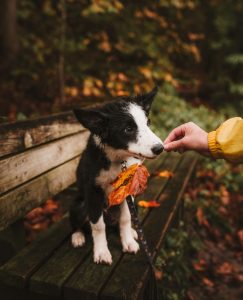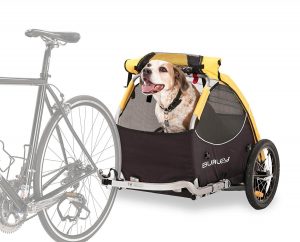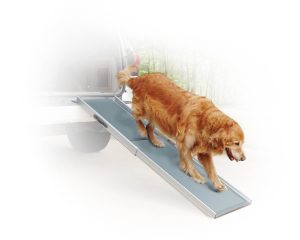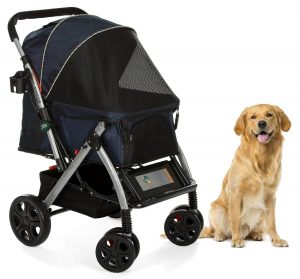Pet Carriers & Travel » Ultimate Guide: Hiking with your Dog
The Ultimate Guide to Hiking with your Dog
Some of us enjoy the great outdoors, but there’s one easy way to make it a whole lot more fun: take your dog with you. If you’re not used to thinking about it, you might not realize that a lot of us take our canine companions with us into nature.
It’s usually not as simple as simply throwing a leash on them and hoping things work out for the best though, but if you put some real thought into it you might just end up introducing your favorite furry friend to a whole new world of adventure… and yourself too.
Deciding on a Trip
The first step in your journey is going to be to find a destination where both of you will be able to enjoy yourselves. Many areas don’t want you hiking with your dog, unfortunately, whether it’s for a good reason or not. If you’re looking for a destination, try www.hikewithyourdog.com to find dog-friendly trails and some ratings for them.
Of course, adventures with your dog aren’t limited to just day trips. If your pup is in good enough shape then even long, backcountry treks are possible as long as you’re careful about equipment selection and make sure you bring enough food.
Pick your area carefully, not everywhere that dogs are allowed is really “dog-friendly” in the truest sense of the word. You’ll want to make sure that you’re not going to deal with any of the following before setting out.
- Trails which are littered with sharp rocks are just asking for injuries. You’ll want to know some doggy first aid either way, but it’s better to not have to practice it in the field if you can avoid it.
- Hot ground is also a no-no for dogs. There are boots out there which will protect them but it’s no guarantee your dog will like them. It’s particularly important to make sure your dog enjoys their first few trips if you want a continuous stream of new adventures with them.
- Lots of mountain bikers or horses. While they’re a minor inconvenience as a hiker, they tend to get a whole lot more dangerous with a dog involved for all parties. If they’re present in smaller amounts then keep a sharp eye, and ear, out and never let your dog off leash. You’ll need to tighten things up if someone is coming up, as you don’t want to clothesline a biker with a leash or have your dog snap at a horse.
- Chaparral and similar scrublands will often leave stickers in your dog’s coat. You’ll want a brush in these cases. Keep an eye on the dog and stop if you need to, those stickers can turn into a problem in a hurry.
- Overly steep slopes are hard for dogs to navigate due to their quadrupedal posture. A fit dog can make it up and down some pretty steep slopes but it’s harder on their bodies than you’d think.
Backcountry spots are attractive to those of us who love being out there but you may not want to go for a week-long backpacking trek without a couple of day trips first even if your dog is ultra-fit in the first place. Their behavior may be quite a bit different than you expect once you hit the trail and you don’t want that element of unpredictability emerging on a longer trip.
Instead, take a couple of short jaunts the first few times out and monitor your canine’s energy levels in the immediate aftermath. If they get back to the vehicle and promptly curl up for a nap, then you’re pushing the edges of their endurance. On the other hand, if they’re chomping at the bit and still super active, then you can push things farther the next time.
If you’re already taking your dog out, then kick back, keep reading, and see if there’s anything that you don’t already know in here to help you and your canine companion on your next adventure.
Picking the Right Equipment
 You’re going to need the right equipment for you and your dog to make sure that everything is nice and spiffy for your whole journey. Instead of just grabbing what you have hanging on the wall, you might want to look into getting some of the following.
There are a few key things to consider when you’re looking at these vests.
You’re going to need the right equipment for you and your dog to make sure that everything is nice and spiffy for your whole journey. Instead of just grabbing what you have hanging on the wall, you might want to look into getting some of the following.
There are a few key things to consider when you’re looking at these vests.
Dog Backpack
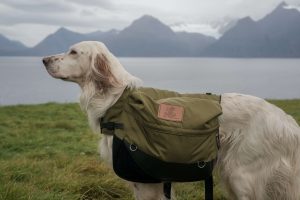 A good dog backpack is pretty much essential, especially for actual backpacking trips where you’ll already have a good portion of your bag filled up. Besides, you drove to the spot, maybe it’s time to let the mutt carry some of their own gear.
Before you settle on a design, grab a tailor’s tape and measure your dog around the chest. Any backpack worth its salt will be sized to be worn in this manner, and it’ll save a lot of trouble with trial and error.
You want to make sure any pack has the following qualities:
A good dog backpack is pretty much essential, especially for actual backpacking trips where you’ll already have a good portion of your bag filled up. Besides, you drove to the spot, maybe it’s time to let the mutt carry some of their own gear.
Before you settle on a design, grab a tailor’s tape and measure your dog around the chest. Any backpack worth its salt will be sized to be worn in this manner, and it’ll save a lot of trouble with trial and error.
You want to make sure any pack has the following qualities:
- A D-ring to attach a leash
- Multiple pockets on each side
- Mesh panels against the dog for ventilation
- Sturdy construction
Leash
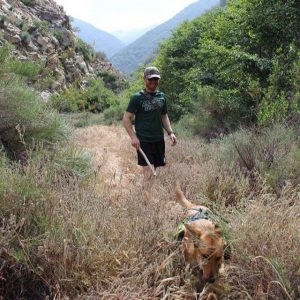 You do not want a long leash on the trail. In the backwoods, a well-trained dog can be let off the leash without too much fear, with some exceptions, but on a trail with other people, anything longer than a heeling leash is just asking for trouble.
Some people like to use a ten foot or so leash, just get some practice at pulling it to heeling length in order to ensure that you don’t inadvertently let your dog loose on wildlife or other people on the trail.
We strongly recommend against a hands-free leash for trails. There are a lot of situations that may call for free movement while you’re on a trail, and you won’t be able to manage it if you’re tied at the hip to your canine.
This is a case where simple is better.
You do not want a long leash on the trail. In the backwoods, a well-trained dog can be let off the leash without too much fear, with some exceptions, but on a trail with other people, anything longer than a heeling leash is just asking for trouble.
Some people like to use a ten foot or so leash, just get some practice at pulling it to heeling length in order to ensure that you don’t inadvertently let your dog loose on wildlife or other people on the trail.
We strongly recommend against a hands-free leash for trails. There are a lot of situations that may call for free movement while you’re on a trail, and you won’t be able to manage it if you’re tied at the hip to your canine.
This is a case where simple is better.
Harness
If you’re just on a day hike, you’ll probably have enough room in your bag for a bit of dog food and an extra water bottle. In that case, you may want to go with a harness for the dog, instead of the standard leash and collar arrangement. A good hiking harness just needs to be sturdy, to be honest. There are specialized harnesses out there with some neat features but as long as it’s sturdy and will allow you to bodily pull your dog without choking them you’ll be in good hands.Dog Boots

 In some areas, these are merely a convenience, but for a lot of us, they’re pretty much essential. If you’re going to be covering hot ground or sharp rocks while you’re on the trail, then carefully consider your purchase.
You need something anti-slip which puts on and off easily. Waterproof is also a good quality, especially for day hikes if you want to keep wet paw prints out of your car.We like these but everyone will have their own taste for these.
Make sure you get your dog used to them before you decide to take them out on the trail.
Most dogs will take to them pretty easily, but some can be a bit more stubborn.
In some areas, these are merely a convenience, but for a lot of us, they’re pretty much essential. If you’re going to be covering hot ground or sharp rocks while you’re on the trail, then carefully consider your purchase.
You need something anti-slip which puts on and off easily. Waterproof is also a good quality, especially for day hikes if you want to keep wet paw prints out of your car.We like these but everyone will have their own taste for these.
Make sure you get your dog used to them before you decide to take them out on the trail.
Most dogs will take to them pretty easily, but some can be a bit more stubborn.
Canine First Aid Kit
Don’t skimp on this part of your dog’s equipment, especially if you’re in the backwoods or have a large dog. Sometimes stuff happens, and if you’re a couple of miles from the road it can be a much bigger deal than you’d think. While you might be able to lug a terrier back to the car without difficulty on a day hike, imagine trying to do the same with a German Shepherd.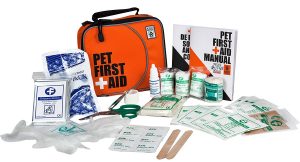 Our pick is pretty similar to a human first aid kit with some minor differences. There are a lot of them out there, but remember to bone up on your own dog first aid knowledge before you hit the trail. Even if you’re an expert with humans, it’ll pay off to do some research on the anatomical differences.
This is an absolute essential though, so make sure you bring one even if it’s just a day trip. Make sure to bring any veterinary pharmaceuticals your dog is required to take as well.
Our pick is pretty similar to a human first aid kit with some minor differences. There are a lot of them out there, but remember to bone up on your own dog first aid knowledge before you hit the trail. Even if you’re an expert with humans, it’ll pay off to do some research on the anatomical differences.
This is an absolute essential though, so make sure you bring one even if it’s just a day trip. Make sure to bring any veterinary pharmaceuticals your dog is required to take as well.
Other Dog Hiking Gear
There’s no end to the list of gear which people recommend. If you’re looking to keep your dog spoiled, some of the following might pique your interest:- Travel water bottles are one of the favorites. They combine a bowl and a bottle for the dog which simply refuses to learn how to drink from their own water bottle and a good one won’t take up much more room than a standard water bottle.
- Collapsible food bowls are another convenient item to carry. As long as they collapse pretty much any bowl will do, allowing you to easily feed your dog without worrying about them munching on dirt.
Cooling vests (see also our article: “Best Dog Cooling Vests”) are a good idea if it’s going to be warm out and there’s a lot of water around. It’ll allow your dog to enjoy the cooling effect from streams for much longer than they’d normally get it. If it’s warm, you need to watch for heat exhaustion anyways, and if you don’t have one a shemagh or scarf can be wetted with a water bottle or stream and wrapped around the neck as a preventative measure.
- Dog towels have a lot more value than you’d think, especially on longer trips. Training your dog to let you wipe their feet before they come in the tent, or drying them off after they take a refreshing dip at the wrong time of the day are both good uses.
- A muzzle. Even the friendliest dog can get a bit snappy if they get injured and it won’t take up much room in the pack. This can keep both of you safe if something happens and their utility shouldn’t be underestimated.
Modifications to Your Gear
You may want to take some extra time to consider your own gear as well, rather than just bringing things for the dog.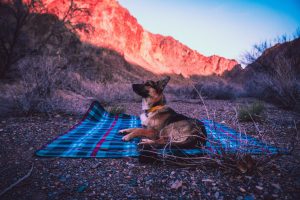 For instance, survival straws have become a common method for hikers to purify water. You simply aren’t going to be able to train a dog to drink out of one, considering they require a considerable amount of suction to get going. Most of them also don’t allow for you to put water into a separate container.
A hand pump filter is a good idea. While dogs are a bit less likely than humans to get sick drinking from wild water sources, they’re definitely not immune and your poor friend is going to be miserable if they do happen to catch one of the diseases which can be found in water.
For instance, survival straws have become a common method for hikers to purify water. You simply aren’t going to be able to train a dog to drink out of one, considering they require a considerable amount of suction to get going. Most of them also don’t allow for you to put water into a separate container.
A hand pump filter is a good idea. While dogs are a bit less likely than humans to get sick drinking from wild water sources, they’re definitely not immune and your poor friend is going to be miserable if they do happen to catch one of the diseases which can be found in water.
 Remember to leave room for your dog in the tent as well, and possibly pack an extra blanket if you’re going to be in for some frosty nights.
Just make sure that you keep your dog in mind when packing, some convenient things that humans can use are actually quite hard to use for a dog without some modification after all.
Remember to leave room for your dog in the tent as well, and possibly pack an extra blanket if you’re going to be in for some frosty nights.
Just make sure that you keep your dog in mind when packing, some convenient things that humans can use are actually quite hard to use for a dog without some modification after all. Getting Ready for the Trail

On the other hand, some dogs simply won’t be ready for the rigors of the trail right off the bat and you’re going to have to invest some time in order to make sure that they’re good to go as on your adventures. It’s an exciting prospect for both of you, really, and you know it’ll be a doggone good time.
It’s definitely a good idea to work up to things, however, especially if your dog is largely sedentary. There’s a number of things to keep in mind about your dog before you get out there:
- Breed: Some breeds of dog will do better than others in the woods. Almost all of them will be fine, but small dogs with a high prey drive may be harder to control while you’re in the woods since they’ll be sniffing bunnies and squirrels all over the place. Remember that smaller dogs are going to be able to cover less ground per day by their nature, they’ll end up having to take multiple steps.
- Age: Older dogs are going to have a harder time on the trail no matter what. Any dog over ten years old or so is going to need a thorough assessment before you hit the trail. Be careful with puppies as well, not only are they smaller but extended periods of hitting the trail can affect their physical development.
- Behavior: Your dog will need to be obedient, no matter where you’re headed. They’re not fully aware of the dangers around them and it only makes sense to ensure that they will listen to you no matter what is going on. On trails with a lot of people, and possibly other dogs, they also need to be well socialized. We’ll go over trail etiquette more in just a bit.
- Overall Health: Even a dog full of energy and vigor can suffer from problems which will make the trail much harder on them. Hip dysplasia is the most common of these, with arthritis coming in a close second. If your dog has any kind of health issues check with your vet and describe your planned trip in detail before you head out.
Once you’ve gotten this done, you’ll mostly need to get your dog used to his gear. This involves… well, having them use it when you’re not on the trail. Taking them for walks with loaded packs and booties is a good start, and you should be able to take them on a long walk with a fully loaded pack and no obedience issues before you actually set out on the trail.
You’ll also want to make sure their nails are trimmed and fur groomed before you go out.
Once all of that’s settled, you’ve still got two things to calculate, food and water.
Most dogs drink about .5-1 ounce of water per pound per day. Smaller dogs will need 1.5 ounces per pound of body weight due to their faster metabolism. As a general guideline, this is pretty effective, if you’re unsure if your dog needs more water or not then check their nose.
For food, start with their normal daily “ration” then add 1 cup for each 20lbs of weight your dog is carrying. This is usually a sufficient amount of food, but this is why we advocate taking your dog on shorter hikes before trying a long backwoods trail since these are general guidelines and each dog is different.
On the Trail
Once you’re on the trail, your job isn’t over. Most dogs make fantastic hiking companions, but if this is their first time getting out of your immediate area you may have a handful to deal with. 
Keep a tight rein on them, the first couple of hikes you’re going to try to ingrain some behaviors to help keep them safe while you’re on the trail.
Canine Trail Etiquette
One of the most important things is to teach your dog how to behave on the trail. Dog-friendly trails can be hard to find, and most of the trails dogs are banned on can be traced back to just one or two unruly owners and their dogs.
Your dog needs to be well socialized around both people and other dogs. If they have a tendency to growl and snap it can make other people on the trail nervous, and the chances of that no longer being a dog-friendly wonderland go up pretty quickly. On the other hand, saying hello to people you pass will help your dog know that they’re a friend and not a foe.
When anyone passes near, keep your dog well-heeled. It will definitely help to keep any incidents from happening. It’s probably best to let your dog greet other pooches which are on the trail but not let them play together, instead keep going.
Remember that in order to keep a trail dog-friendly, particularly a widely populated one, it’s important for both dog and owner to be polite and courteous since a couple of reports is all it takes to shut down the dog-friendliness of a formerly great trail.
General Guidelines and Hazards
There are some general guidelines for hiking or backpacking with dogs that you’ll need to make sure of before you get going:
Always make sure that there are at least as many people as dogs in the group. Preferably one extra person just in case. No matter how well behaved, you don’t want dogs outnumbering people and having a friend along can be useful for both of you in case something happens.
- Don’t go on popular trails with more than two dogs. Dogs have a tendency to “pack up” in these situations and it can intimidate other hikers. If you’re in the backwoods it’s a little bit different, but all of the pups present should have some experience outdoors.
- Follow “Leave No Trace” rules. On day hikes you can double bag their poop if you’re worried about escaping fecal matter in your bag, on longer trips bury their poop at least 6-8” and 100 yards away from any running water. Don’t just leave it out.
- Always ensure a tight rein on the dog if passing others, and especially if there are bikers or horse riders on the trail. Both of those groups can be harmed pretty severely if they get clotheslined with a leash or a horse gets spooked.
- Make sure your dog is completely vaccinated well before you head out on the trail. Ask your vet for guidelines, but as a general rule, this is super important. There are a lot of pathogens in the wilderness which they won’t run into while lounging on the couch at home.
- Don’t let your dog off leash at the campsite, especially if they’re not extremely well trained. Consider carrying a 25-30’ cable and stake to let them roam around while you’re not in the tent.
- Do your best to keep your dog from trampling plants and chasing wildlife. Some plants are quite fragile, and it’s obviously not a great idea to disturb animals for both your safety and theirs.
The above are pretty easy to follow, and both of you will benefit from them.
Wildlife on the Trail
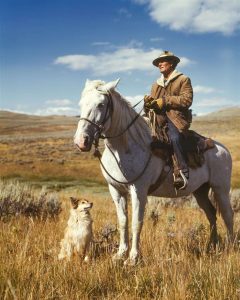
The “alert” behavior will depend on the dog. Some will growl, some will want to forge on ahead aggressively, and others might just decide to lay down in the middle of the trail and only budge with their leash being tugged. Which dog does which might surprise you, and some dogs may not alert at all but it can be a good indicator.
If you’re wilderness savvy yourself and notice this behavior, it may be time to keep a sharp eye out for the different signs that predators leave behind. Canine predators, like wolves and coyote, will often leave scat, bears mark trees with slashes, and even though they’re quite elusive even mountain lions will leave tell-tale paw prints and other signs.
If you do happen to encounter a large mammal, keep a tight rein on your dog and go through the usual motions(make yourself larger, ready bear spray, or whatever else is recommended in your area). Chances are most predators won’t mess with a ready dog and human. It’s probably time to get out of the area once they’re scared off, however, and make sure you keep your dog in your tent if you can’t get back to civilization within the day.
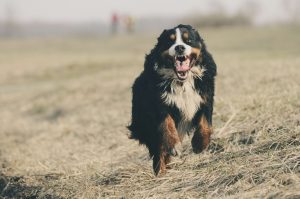
On the flip side of things, keep your dog from chasing smaller ground animals like chipmunk and squirrel. This can be really difficult with terriers and other dogs which have been bred for going after smaller animals, but it’s pretty much a must. While it’s fairly natural for a dog to kill and eat small mammals, it may disconcert others and it’s a good way to end up with a sick dog.
Falls
A dog’s exuberance in the wild is a wonderful thing to watch.
And you’d better watch it carefully along ridges and cliffside trails.
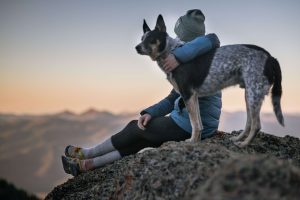
More than that, younger dogs are often still clumsy. Keep them on a tight leash in these kinds of areas, and try to keep them as far from the edge as possible.
Flora
Depending on the area you’re in, chances are there’s at least one poisonous plant around. Poison oak, in particular, can render a dog completely miserable.

You also need to keep plants safe from your dog. Remember the “Leave No Trace” rule, this means not letting your pup run roughshod over everything they come across, especially in alpine environments where plants are often rare and quite fragile.
At the very least, you need a decent knowledge of the flora in the area. If a dog chews on something which is going to make them sick it’s time to turn back and get the dog to a vet. Hopefully, they’ll be able to make it back on their own, but you may end up carrying them for a while.
Water
Water poses two risks to dogs:

Regardless, since they’re much shorter than us you’re going to want to test both the stream’s speed and depth before you send your furry friend across. A stick thrown can let you see quick currents you barely notice and probing ahead with a stick will let you see the depth pretty easily.
Try to find a shallow and slow spot to cross if you can. In most cases, it’s best to take your dog’s pack across first then re-leash them and lead them through the water. If you can’t find a suitable spot, you may need to pick your adventurous mutt up and carry them through.
The second risk is much more insidious. Giardia can infect dogs which drink from infected water sources. While it often doesn’t show symptoms for some time, you’ll want to take a stool sample to a vet when you get back from a multiple day trip to see if they’re infected.

Be careful about letting your dog get into water when it’s cold as well, if it’s particularly chilly it’s best to dry them off as soon as you’ve crossed in order to keep them from hypothermia. If it’s warm out, however, water offers a chance to charge cooling vests or scarfs in order to keep their temperature down.
Creepy Crawlies
A little bit different from wildlife, there are a lot of arthropods out there that can make things worse for your dog in a hurry.
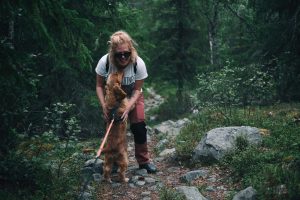
Depending on what’s in the area, you’ll also need to keep an eye out for anything with a good sting or bite. This can include various spiders, scorpions, and even larger flying insects depending on where you’re hiking.
Dogs also have a tendency to stick their noses where they shouldn’t. This can lead to an encounter with bees, hornets, or one of the various varieties of stinging ants pretty easily. Try to keep an eye out for nests, tunnels, and hives but chances are it’ll happen sooner or later if your dog is curious.
Exhaustion and Temperature

Learn to monitor their energy levels. One of the best ways to do this is to see how long it takes for a dog to get back to baseline levels when you take a break. When it starts taking longer than average it may be time to head back or start looking for somewhere to make camp since this is an obvious sign of exhaustion.

On the other side of things, you need to make sure they don’t get too cold as well. It can be just as dangerous after all.
Avoid letting your dog wet their fur after it starts getting dark. This will keep them wet and can cool them off far too much. If you have to cross a stream or creek at this time, then be sure to dry them off as soon as the two of you navigate the crossing.
If your dog ends up getting heat exhaustion, despite your best efforts, help them to cool down in the shade. Don’t do anything too drastic, which can cause thermal shock, but instead laying a wetted scarf or towel over them and finding a nearby place to rest for the night is probably your best option. Smaller dogs can usually be carried back.
For a hypothermic dog, you’ll need a blanket and a towel to dry them off as much as possible before you head in.
The Most Important Part – Having Fun!
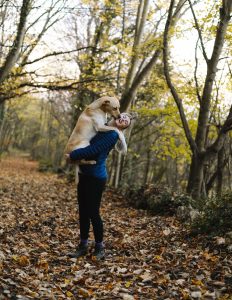
Chances are that the two of you are going to have quite an adventure. After all, thousands of dogs go on thousands of trails every year without any incident. As long as you’re geared properly and know what to keep an eye out for… well, the two of you might just have the best doggone time ever.
So start training Fido for your next adventure as soon as possible, hiking is always rewarding and doing it with your favorite animal companion just adds a whole new level to the great time you’ll be sure to have.
Share:



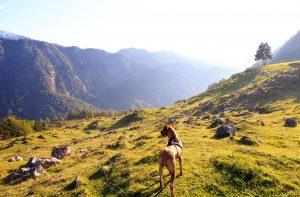
 Instead, take a couple of short jaunts the first few times out and monitor your canine’s energy levels in the immediate aftermath. If they get back to the vehicle and promptly curl up for a nap, then you’re pushing the edges of their endurance. On the other hand, if they’re chomping at the bit and still super active, then you can push things farther the next time.
Instead, take a couple of short jaunts the first few times out and monitor your canine’s energy levels in the immediate aftermath. If they get back to the vehicle and promptly curl up for a nap, then you’re pushing the edges of their endurance. On the other hand, if they’re chomping at the bit and still super active, then you can push things farther the next time.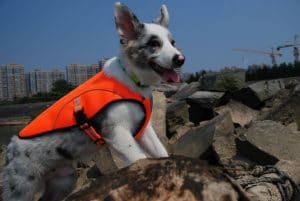

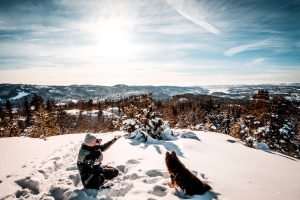

 Always make sure that there are at least as many people as dogs in the group. Preferably one extra person just in case. No matter how well behaved, you don’t want dogs outnumbering people and having a friend along can be useful for both of you in case something happens.
Always make sure that there are at least as many people as dogs in the group. Preferably one extra person just in case. No matter how well behaved, you don’t want dogs outnumbering people and having a friend along can be useful for both of you in case something happens.